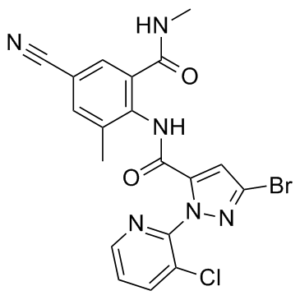This product is for research use only, not for human use. We do not sell to patients.

| Size | Price | Stock |
|---|---|---|
| 5mg | $70 | 3-6 Days |
| 10mg | $100 | 3-6 Days |
| 25mg | $170 | 3-6 Days |
| 50mg | $300 | 3-6 Days |
| 100mg | $500 | 3-6 Days |
| 250mg | $1080 | 3-6 Days |
| 500mg | $1550 | 3-6 Days |
Cat #: V2870 CAS #: 736994-63-1 Purity ≥ 99%
Description: Cyantraniliprole (also known as HGW-86), an anthranilic diamide analog, is a novel and potent second-generation insecticide which is able to deter insect feeding and reduce disease transmission. Cyantraniliprol is a valuable tool for managing Frankliniella occidentalis (Pergande) and also is as effective as abamectin in deterring potato psyllid feeding and could significantly reduce transmission of Lso and the spread of ZC. Cyantraniliprole is approved for use in the United States, Canada, China, and India. Because of its uncommon mechanism of action as a ryanoid, it has activity against pests such as Diaphorina citri that have developed resistance to other classes insecticides. Cyantraniliprole is highly toxic to bees, which resulted in registration of its use as a pesticide being delayed in the USA.
Publications Citing InvivoChem Products
Product Promise

- Physicochemical and Storage Information
- Protocol
- Related Biological Data
- Stock Solution Preparation
- Quality Control Documentation
| Molecular Weight (MW) | 473.71 |
|---|---|
| Molecular Formula | C19H14BrClN6O2 |
| CAS No. | 736994-63-1 |
| Storage | -20℃ for 3 years in powder form |
| -80℃ for 2 years in solvent | |
| Solubility In Vitro | DMSO: 10 mM in DMSO |
| Water: <1 mg/mL | |
| Ethanol: | |
| SMILES Code | O=C(C1=CC(Br)=NN1C2=NC=CC=C2Cl)NC3=C(C(NC)=O)C=C(C#N)C=C3C |
| Synonyms | HGW-86; HGW86; HGW 86. |
| Protocol | In Vitro | In vitro activity: Cyantraniliprole (also known as HGW-86), an anthranilic diamide analog, is a novel and potent second-generation insecticide which is able to deter insect feeding and reduce disease transmission. Cyantraniliprol is a valuable tool for managing Frankliniella occidentalis (Pergande) and also is as effective as abamectin in deterring potato psyllid feeding and could significantly reduce transmission of Lso and the spread of ZC. Cyantraniliprole is approved for use in the United States, Canada, China, and India. Because of its uncommon mechanism of action as a ryanoid, it has activity against pests such as Diaphorina citri that have developed resistance to other classes insecticides. Cyantraniliprole is highly toxic to bees, which resulted in registration of its use as a pesticide being delayed in the USA. Kinase Assay: Cell Assay: |
|---|
| Solvent volume to be added | Mass (the weight of a compound) | |||
|---|---|---|---|---|
| Mother liquor concentration | 1mg | 5mg | 10mg | 20mg |
| 1mM | 2.1110 mL | 10.5550 mL | 21.1100 mL | 42.2199 mL |
| 5mM | 0.4222 mL | 2.1110 mL | 4.2220 mL | 8.4440 mL |
| 10mM | 0.2111 mL | 1.0555 mL | 2.1110 mL | 4.2220 mL |
| 20mM | 0.1055 mL | 0.5277 mL | 1.0555 mL | 2.1110 mL |
This equation is commonly abbreviated as: C1 V1 = C2 V2
- (1) Please be sure that the solution is clear before the addition of next solvent. Dissolution methods like vortex, ultrasound or warming and heat may be used to aid dissolving.
- (2) Be sure to add the solvent(s) in order.




































